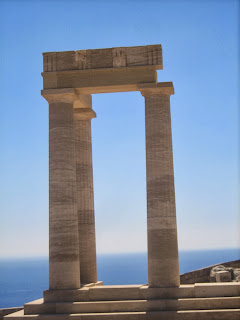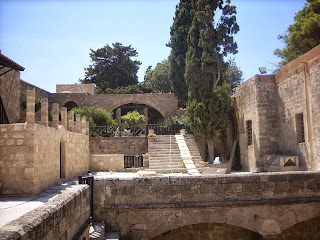The Island of Rhodes
It seems that no
sooner than we take down the Christmas decorations that we have to decide where
we are going on our summer holidays. So where are you planning to go this
summer? If you are thinking of a Mediterranean holiday on one of the
Greek Islands, why not consider travelling to the beautiful island of Rhodes?
Rhodes is a Greek Island in the Dodecanese that sits
approximately eleven miles off the coast of Turkey in the Aegean Sea. Rhodes is one of the larger Greek islands, covering
some 1398 square kilometres and with a coastline of 220 kilometres, and has a
population of around 117,000. The interior of Rhodes is mountainous and the
slopes are covered with forests.
 |
| Entrance to Harbour, Rhodes Town |
Rhodes has a history of human habitation stretching back to
Neolithic times. Early settlers came
from Asia Minor and there are traces of Mycenean habitation. They were followed by the Dorian Greeks, and
the state of Rhodes was founded around 408BC when the three major cities on the
island, - Ialyssos, Kamiros and Lindos joined forces and forged a political
union. The next three hundred years were
the golden age of Rhodes, and it was during this period that the famous
Colossus of Rhodes was erected. The
Colossus was one of the Seven Ancient Wonders of the World, and was a
representation of the sun god Helios. It
was the work of the Lindian sculptor Hares, and took twelve years to
complete. The site where The Colossus
once stood can still be seen today at the entrance to the harbour in Rhodes
Town.
Rhodes became a province of the Roman Empire and after the
split of the Empire in the beginning of the 4th century AD became
part of the Eastern, or Byzantine, Empire.
In the ensuing centuries Rhodes was invaded by the Arabs and in 1309 was
sold to the Order of the Knights Hospitallers of St John of Jerusalem. The Knights were established to nurse pilgrims
to the Holy Land and the Crusaders who fought there. In 1522 the island was conquered by the
Ottoman Turks after a long siege. Rhodes
was part of the Ottoman Empire until 1912, when it was occupied by Italian
troops, and then at the end of the Second World War was incorporated in Greece
along with the other Dodecanese islands.
Why is Rhodes Such A Good Place To Holiday?
The Airport
Rhodes is one of the Greek islands that have an international airport. During the summer season there are many
charter and low-cost flights to Rhodes from the United Kingdom, and regular
scheduled flights from Athens and other major Greek cities. So if you like your holidays to be
straightforward and the travelling short, there is no need to fly into Athens
and wait around for a ferry.
 |
| Lindos |
The Climate
Rhodes is an island of sunshine, with the ideal climate for basking on the
beach. The average temperature during
the summer months is around 30 degrees centigrade, with temperatures in the
winter rarely dipping below 10 degrees centigrade. It also very rarely rains during the summer
months of June, July and August; the bulk of the island’s rainfall occurs
during the winter. There are local
variations in temperature and Lindos, due to its position, is often a good 10
to 15 degrees centigrade hotter than other parts of the island.
The Beaches
There is a beach on Rhodes to suit everyone, from tiny little coves with very
few people and no facilities, to long sandy beaches with large crowds, sun
beds, umbrellas and lots of cafes and bars.
Perhaps on of the most dramatic beaches is Prasonisi on the southern
most tip of the island. On one side you
have calm waters and shelter from the wind and on the other side wild waves,
wind and surfers. There is even a beach
called Anthony Quinn, after the Hollywood actor who bought that part of the
island when he was on Rhodes filming ‘The Guns of Navarone’.
 |
| The Beach at Lindos, Rhodes |
The Resorts
Like the beaches there is a resort on Rhodes that will appeal to everyone. The resort of Faliraki is best known for its
loud, bustling nightlife, but it also has a 5 kilometres long beach, lots of
shops and is home to the Faliraki Water Park, one of the largest in Europe. The resort of Lindos is a beautiful old town
clinging to the cliff as it leads down to the sea. There are a multitude of shops, cafes and
tavernas, many with roof terraces where you can dine under the stars looking
out over the sea or up to the illuminated ancient Acropolis. There are many resorts to choose from;
offering accommodation from all-inclusive 5 star hotels to simple rooms in
tavernas or private homes.
 |
| Empty Beach, Rhodes |
The Archaeological Sites
Rhodes has a long and interesting history, and boasts many
impressive archaeological sites. These include
the ruins of the ancient towns of Kamiros, Lindos and Ialyssos. At Ialyssos there are remains of a temple
dedicated Athena Polias, a Doric fountain house, some Byzantine fortifications,
remains of a Minoan settlement and Mycenean cemeteries. At Kamiros
you can wander around the remains of the old city, which was rediscovered in
1929 and is sometimes known as the Greek Pompeii, as it is not known why it was
that the city was deserted and buried.
Lindos, with its magnificent Acropolis towering above the town, is
arguably the most famous of the three.
You can either walk up the steep path from the town or take a ride on
one of the donkeys, and enter the fortifications and the ruins of the temple of
Athena Lindia. There is also an ancient
theatre in Lindos and various ancient funerary monuments. There is an excellent Archaeological Museum
in Rhodes Town containing many interesting artefacts, although many of the rich
finds from Kamiros are in the British Museum and the Louvre.
The Interior of the Island
The hills of Rhodes are covered with trees and vegetation. There are magnificent views down to the
coastline and there are many little villages and towns dotting the
landscape. There are also numerous
churches and monasteries and you can visit the picturesque Valley of the
Butterflies.
 |
| Interior of Island, Rhodes |
Rhodes Town
The
jewel in the island’s crown is Rhodes Town itself. It was declared a UNESCO World Heritage Site
in 1988, and is also the financial and cultural centre of the south eastern
Aegean. The old town of Rhodes is a maze
of around 200 streets and lanes, encircled by the town walls. You enter the old town through one of the
great gates, and can visit the ruins of the Temple of Venus, the Municipal Art
Gallery, the Museum of Decorative Arts, the Archaeological Museum, the Church
of Our Lady of the Castle and the Palace of the Knights. There are many shops, cafes and
tavernas. Outside the walls is Mandraki
Harbour with its two deer statues where it is believed stood the mighty
Colossus of Rhodes, the larger harbour where the cruise ships tie up, the
Casino and along the beach is the Aquarium.
 |
| Rhodes Town |
There truly is something for everyone on a Rhodes holiday,
so why not book your tickets today and look forward to long, sun-filled days
and nights of moonlight, dancing and great food.
All images my own
.JPG)
.JPG)
.JPG)
.JPG)
.JPG)
.JPG)

.JPG)
.JPG)
.JPG)
.JPG)















